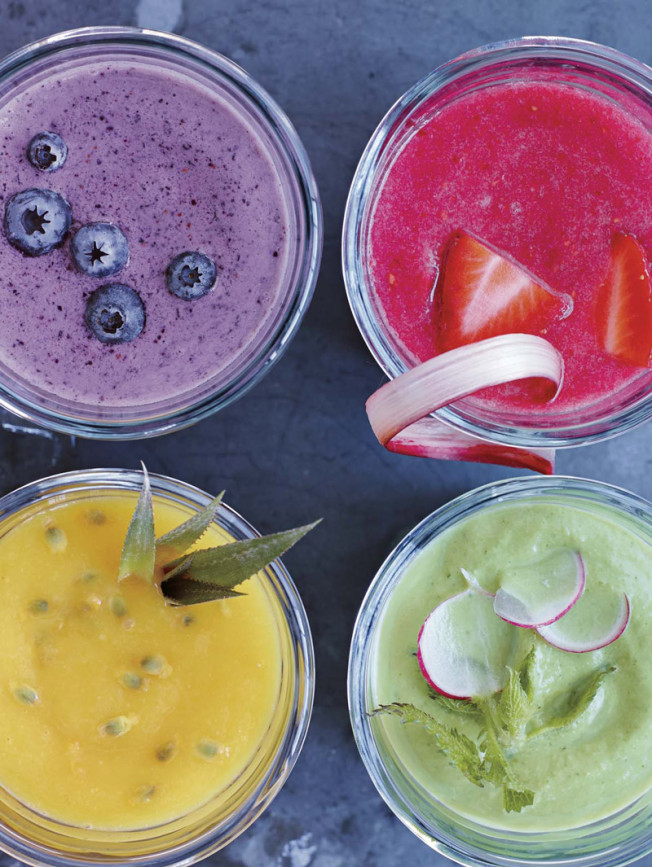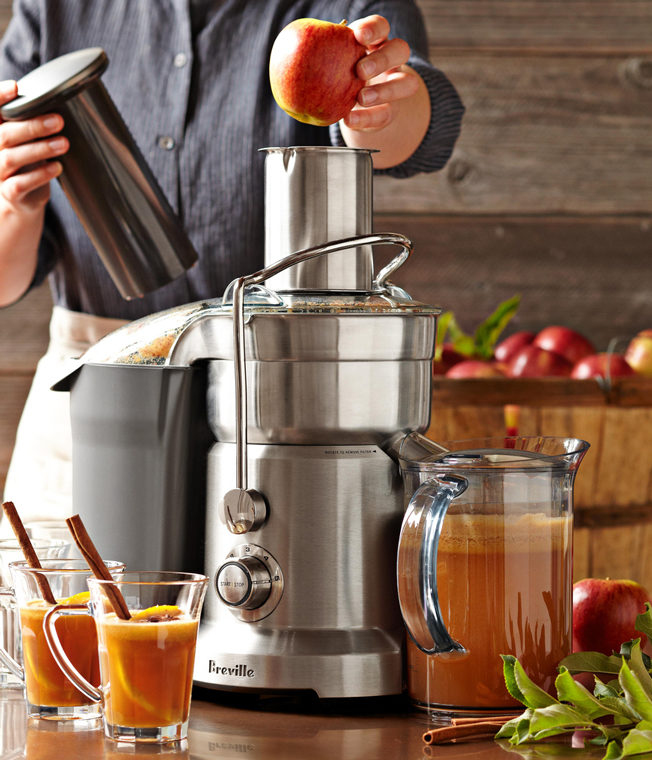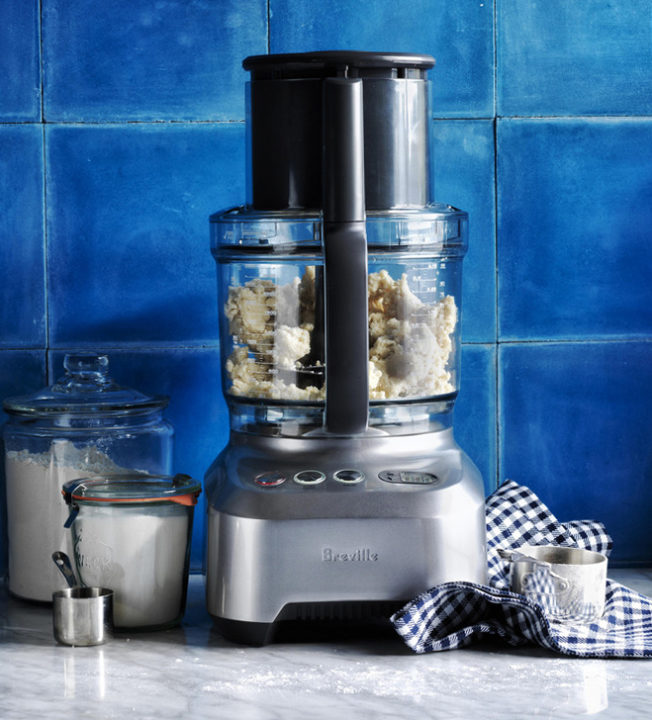
At first glance, blenders, food processors, and juicers all seem to perform the same basic action: transforming food from solid to somewhere on the spectrum of spreadable to sippable, but that doesn’t mean they’re interchangeable. Each appliance has its own strengths and weaknesses, and, aside from a few exceptions, most recipes are best made using one, and only one, of these time-saving tools. For the most part, it comes down to a matter of mechanics. Once you understand the basics of how each appliance works, you’ll be able to easily answer when you should use which; here, we break it all down for you.
How a Blender Works

An upright blender works by using a narrow, angled carafe to keep ingredients engaged with the blender’s blade. Typically, blenders pair a super-charged motor with a strong and sturdy, moderately-sharp blade. Blenders have the largest volume capacity of the three, meaning they have no problem blitzing a batch of soup, but are less good at super-small-batch tasks.
Blenders Are the Best Appliance For Making Smoothies and Puréed Soups
A blender is the the best choice for puréeing liquid-heavy mixtures, like smoothies. A juicer strips away the pulp and fiber, a desirable trait for a smooth green juice, less so for a thick smoothie. Overload your food processor’s bowl with liquid and you’re heading towards a leaky mess. Texturally, puréed soups and smoothies have much in common, so like with smoothies, a blender is the way way to go when taking a soup from chunky to smooth. A handheld immersion blender can make quick work of this task, dirtying fewer dishes in the process, but for the silkiest results, use a high-powered upright blender, like a Vitamix.
High-powered blenders can easily crush ice for frozen cocktails—frozen margaritas, anyone?—and can take on some recipes typically best reserved for a food processor, like nut butter and nice cream. They can also be used for juicing when paired with a fine-mesh strainer or jelly strainer bag.
How a Juicer Works

Fruit and vegetable juicers are broken down into two categories: centrifugal and masticating (a.k.a. slow or cold-press). Centrifugal juicers work by very-finely grating produce and then rapidly spinning the pulp in order to separate the liquids from the solids. Masticating juicers use a combination of crushing and pressing produce through interlocking gears in order to break down the cell walls of the fruits and vegetables, extracting the juice. Masticating juicers have a greater yield and are a better choice for extracting juice from delicate items like leafy greens and herbs. The downside: masticating juicers are more expensive than their centrifugal counterparts.
Juicers Are the Best Appliance For Juicing Fruits and Vegetables
While a high-powered blender can be used in conjunction with a fine-mesh strainer to juice fruits and vegetables, a dedicated juicer is better at the task, extracting more nutrients and creating less mess. Juicers are also the way to go when working with either very hard items like ginger and carrots or delicate items like leafy greens, as a blender will have a trickier time breaking these down. (If using a blender to purée these items, first finely chop or grate them.)
How a Food Processor Works

Food processors have a wide shallow bowl, a very-sharp blade set low in the bowl, and a moderately-strong motor. The combination of a very-sharp blade and a less-strong motor allows for a motion more similar to using a knife to cut through food, rather than puréeing using force. Most food processors come equipped with a variety of interchangeable blades, such as shredding and slicing disc or a plastic dough blade.
Food Processors Are the Best Appliance For Chopping
Compared to a blender or juicer, food processors allow for more precision, and are the superior choice for mincing and chopping fruits, nuts, and vegetables, blitzing chunky mixtures, and combining dry ingredients. In addition to being the best choice for making pesto, hummus, and nut butters, a food processor can also be used to make some doughs like pie crust, shortbread, and pizza dough, and for grating hard cheeses or making breadcrumbs. When equipped with a shredding of slicing disc, a food processor can be also be used to shred or slice.
The downside: food processors do not do well with large quantities of liquid-heavy mixtures. Liquid tends to slosh around in the bowl (a blender’s steep sides corral liquid better), and while food processors allow for easy swapping of blade types, this same interchangeability means that the blade is merely fitted over the bowl’s center rather than screwed in and watertight like with a blender, so liquids can leak out of the center of the bowl, creating a mess.
A good rule of thumb to keep in mind when deciding whether you should use a food processor or a blender is: if a mixture is more solid than liquid, use a food processor, if a mixture is more liquid than solid, use a blender.
If you only have space or budget for one appliance, consider what you like to cook most. Generally, we’d recommend investing in a high-quality blender first, as it’s the most versatile of the three. While it’s not an entirely-perfect solution, a high-powered blender can be used in conjunction with a fine mesh strainer to make a variety of juices, and can also take on some tasks best done in a food processor, like processing nut butters, hummus, pesto, and other thick purées. That said, if you dream of cutting back on time spent chopping and shredding, or are a green juice fanatic, your priorities may be different; shop accordingly!

20 comments
Very well detailed and depth research information cleared so many confusions.
Please keep sharing this kind of informative stuff. Thank you/
Love this article! I really like this article so much. Thanks for sharing
I never got to read about celery juice before but I really liked this post.I am currently busy in finding out Disaster Relief Cleanup Crew helping links but as I get free I shall try this juice to see its results. Thank you very much for sharing such an amazing update.best citrus juicer
this is an excellent comparison between blender and juicers, it helped me a lot in selecting a blender for my kitchen.
Hy, Thanks for sharing these amazing tips and differences. It helps me a lot.
Thank you, I have just been looking for information about this topic for a while and yours is the best I have discovered so far. But, what concerning the bottom line? Are you certain concerning the source?
Wow Great Article Man
The writer did a very good job explaining the core job of juicer and blender. They may seem similar by=ut there are some difference between them, I liked the style of writing. Very helpful post, Thanks for sharing
I like the way you have explained very well that made it easy for me to decide
Excellent tips and i agree with you on using blender for making juice but there is some risk of using it as it is better to use a juicer
Excellent advice, especially regarding trying to use a blender to make juice. While it can be done, it doesn’t mean you should do it. Each appliance has it’s own benefits and special uses .
[…] https://blog.williams-sonoma.com/juicer-vs-blender-vs-food-processor/ […]
There is no doubt, if you want to make juice then you should use a good juicer. Blender is not good for making juice.
Some good tips in here. I agree in terms of versatility blenders are the best but in terms of nutrients juicers the way to go.
I wish I could have read this before buying my Kuvings slow juicer. I wanted a versatile appliance that could work either as a juicer/blender or Juicer/food processor. Having being disappointment the first time, I found Omega Nutrition center to be fitting my needs. This has helped me in minimizing the chance of choking my kitchen with necessary appliances.
Hi
Really glad to read this article. This article is beautifully explained and very beneficial for all the cooking masters including me. Keep sharing such informative posts.
Hello There, Glad to find your Article about Blender, Juicer, Food Processor’s Difference. You just did it very nicely, I’m Smoothie lover, hope you posted another Informative Article like this…
Thanks for explaining the differences. Helped a lot!
Wow, very nice! But can you do this with the best airfryer? Let’s hope that you can!
Me gusta